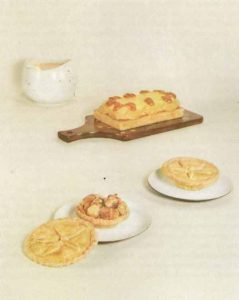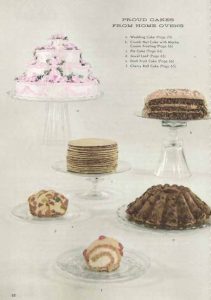Creative Cooking Made Easy: The Golden Fluffo Cookbook was published in 1956 by the Procter & Gamble Company, in collaboration with Seranne & Gaden, the food consulting company run by the two women who quietly shaped midcentury American cooking. It’s a handsome little book, spiral-bound for easy use in the kitchen, decorated with Eileen Gaden’s innovative food photography, and clearly built to last — my copy from the original printing is still in excellent condition, nearly sixty years since it first came off the press.
It appears to be a handy, practical little cookbook. But I have no idea how any of the recipes would taste. It’s impossible to make any of them. Every single one requires Golden Fluffo, a product that hasn’t been manufactured since before I was born.
Golden Fluffo was a canned shortening manufactured by Procter & Gamble from the early 1950s through the mid-sixties. One of it’s chief selling points was that it was a golden yellow in color, which made it better than other shortenings. But don’t take my word for it. Here’s Mike Wallace to tell you more about Golden Fluffo:
There have been other ingredients lost to history. It’s been some time since anyone dined on auruchs or seasoned a plate with laser. Plants and animals go extinct, or their species are altered so greatly through human intervention and selective husbandry that the favors of our foods today bear only a tangential relationship to how they would have tasted two thousand years ago. Unless we have some Jurassic Park style cloning breakthrough, these foods will remain gone. Of course, in the case of such a breakthrough, I’m almost certain that the snack bar at Jurassic Park will be serving stegosaurus on a stick. It’ll probably taste like chicken.
 There are, however, other categories of foods that are lost to us. Foods that are not naturally occurring, but manufactured. These foods disappear when the society around them changes, and the institutions that make them can no longer support their production, or are themselves no longer supported. The most famous example is probably garum, the Greek and Roman fish sauce that was an essential ingredient on any Classical table.
There are, however, other categories of foods that are lost to us. Foods that are not naturally occurring, but manufactured. These foods disappear when the society around them changes, and the institutions that make them can no longer support their production, or are themselves no longer supported. The most famous example is probably garum, the Greek and Roman fish sauce that was an essential ingredient on any Classical table.
Garum was manufactured in tremendous quantities throughout the Mediterranean world. It was produced by fermenting fish in large vats or stone-lined pits, essentially letting the fish’s own stomach acids and some helpful bacteria break down the flesh of the fish into liquid. This may not sound particularly appetizing, but one of the main products of protein decomposition is glutemates, those tasty little chains of amino acids that give the umami flavor spectrum it’s distinctive salty, meaty flavor. Garum, in other words, was Roman soy sauce.
We know that garum was manufactured in different varieties, styles, and grades. There is even some evidence that there was a kosher-certified variety. Whatever the variety, garum was was produced in vast quantities, and that the fish factories that made the sauce were so prevalent (and the odor of fermenting fish so powerful) that the locations they could be placed within a city were strictly regulated.
The vast scale of garum production was also its undoing. As the Roman Empire slowly crumbled, the complex supply and trading networks that had enabled the manufacturers to operate also began to collapse. The manufactures lost their means of distribution — when the roads crumbled and the cargo ships stopped sailing, they could no longer reach their markets. Garum gradually disappeared from the tables of the Empire, and as the long, slow transition to the middle ages began the sauce gradually faded from memory. It was still made on a very local scale in Italy until about the 14th century, but then disappeared into the realm of historical curiosity. Until now.
When I was in college, studying Classics, garum was still very much a thing of the past. One of my Latin professors held it up as an example of just how disgusting Roman food probably actually was. But since then, through the recovery of some original recipes, some particularly adventurous experimental archaeology, and some chemical and DNA analysis on some jars of the sauce recovered from a shipwreck that have allowed us to identify at least some of the types of fish used in manufacturing garum, we’ve actually managed to recreate the stuff. It’s once again fashionable again. I’ve had some of these recreated sauces. They’re actually very flavorful and quite tasty.
 I have to wonder if a similar fate awaits Golden Fluffo. Commercial shortenings were introduced in the early twentieth century and received a tremendous boost in popularity with the publication of Upton Sinclair’s The Jungle. Sinclair’s depictions of workers disappearing into rendering vats of Chicago’s commercial slaughterhouses definitely bubbled up into the popular American imagination.
I have to wonder if a similar fate awaits Golden Fluffo. Commercial shortenings were introduced in the early twentieth century and received a tremendous boost in popularity with the publication of Upton Sinclair’s The Jungle. Sinclair’s depictions of workers disappearing into rendering vats of Chicago’s commercial slaughterhouses definitely bubbled up into the popular American imagination.
Sinclair had originally intended the book to spurn popular outrage about working conditions in these factories, what he soon discovered was that the vast majority of Americans didn’t give a rat’s ass about worker’s rights as long they were sure that the hot dogs they were eating were 98.7% free of rats’ asses. Hydrogenated shortenings, with their guarantee of natural purity, began flying off the shelves.
Fluffo was introduced by Procter & Gamble to accompany its already successful Crisco shortening because — well, I have no idea why they introduced it. All I really know about it is that it’s color was golden yellow. If it tasted any different from Crisco, or if there was a reason why it needed to be yellow, I honestly don’t know.
In the introduction to Creative Cooking Made Easy: The Golden Fluffo Cookbook, the Home Economics Department of The Procter & Gamble Company (no, really, that’s how the introduction is signed) writes:
How many times have you held back from doing something “interesting” to food because you weren’t quite daring enough? Something like stirring herbs or spices into golden biscuit dough … Or deep-frying potatoes, onions and shrimp all at one time … Or fashioning an entire casserole out of pastry so that you can eat the golden-brown casserole, cover and all? Now with this book you can add this kind of excitement to your everyday cooking without taking any chances on what the finished result will be. You can be a “creative cook” the safe way!
And as a wave of consciousness begins to rise towards a young Betty Freidan, the Home Economics Department at the Procter & Gamble company goes on to write:
You have for the first time at your disposal one perfect home-baking ingredient— a fluffy-rich, golden shortening called Golden Fluffo. This startlingly new product has ushered in an entirely new concept in home baking. It is a shortening which blends quickly and naturally with flour, forms a dough so easily managed that even the novice in the kitchen can produce mouth-watering, golden, appetizing results.
It’s easy to mock the cheerful optimism and slightly authoritarian condescension of early 1950s marketing copy, so that’s less work for me, then. Even if Golden Fluffo’s golden color was as fluffy-rich as promised, I’m hesitant to grant that it was actually startling. And if it did effect certain novices in the kitchen in such a way, is it really such a good idea to give responsibility for a vat of bubbling hot fat to a young bride who is startled by a can of shortening?
 Over the past century, industrialized food production has completely transformed the human relationship to food. This transformation goes beyond just the consequences of virtually eliminating starvation in huge swaths of the world — and introducing all sorts of previously unknown health problems along with this abundance — to changing our relationship to our own culture, its tradition, and our own personal histories.
Over the past century, industrialized food production has completely transformed the human relationship to food. This transformation goes beyond just the consequences of virtually eliminating starvation in huge swaths of the world — and introducing all sorts of previously unknown health problems along with this abundance — to changing our relationship to our own culture, its tradition, and our own personal histories.
We were able to reproduce garum because the processes surrounding the production of the sauce were reproducible on a small, human scale. But Fluffo? How can I and my food archaeologist friends make that at home? Should I bring the blended fats together in a small saucepan and, as the fat is still simmering, pour in a cup of hydrogen and whisk, gently. Taking care not to overblend – you want the mixture to be hydrogenated, but only partially, and once the hydrogen is mixed in, add less than 1% butylated hydroxytoluene and artificial coloring, remove from the heat and let cool. Will that get me that fluffy-rich golden yellow taste?
When the knowledge of how to make a food becomes professionalized, or even institutionalized, it becomes much easier for that knowledge to be lost. When recipes become commercial secrets, and the processes to make the ingredients that go in to those recipes are so complex that no single person can hold all the specialized knowledge required to make something as apparently simple as a can of shortening, we become disconnected from our food, and our culture.
Take a look at this staggeringly long list of discontinued food brands. Now, I’m not particularly crying over the loss of Kool-ade Purplesaurus Rex, even though I remember that this was the last flavor of Kool-ade that I ever drank, and that was nearly thirty years ago. But I’m sure Purplesaurus Rex is a deeply nostalgic fossil from someone’s childhood. If the foods we eat as children change with commercial whims from one generation to the next, there’s no shared flavors to build a culture on.
It took over a millennium for garum to completely disappear from the tables of the world. Fluffo came and went in less than a full score of years. Indiana State Baking Champion Thelma Stymer walked in to the A&P one day and her award-winning pie strategy was no longer playable. Neither her children, her grandchildren, nor Mike Wallace would ever again experience the fluffy-rich taste of her apple pies.
Just as I have no idea what Fluffo actually tasted like, I have no idea if the disappearance of Golden Fluffo is a tragedy or a farce. A few appropriately insane archaeologists can figure out how to make fish rot in a way that tastes good, but food manufactured on the scale of Golden Fluffo makes it impossible to recapture once the institutions that manufacture it are gone, or decide that it’s simply no longer profitable. Food is culture. Like any other part of the culture, it’s a good idea to keep track of who owns it.
But even with Fluffo gone, the recovery of garum has shown us that there’s still hope. As Creative Cooking Made Easy says, you, too can be a creative cook. It’s just that now when you are cooking creatively from the book, you have to find a creative substitute for Fluffo.
